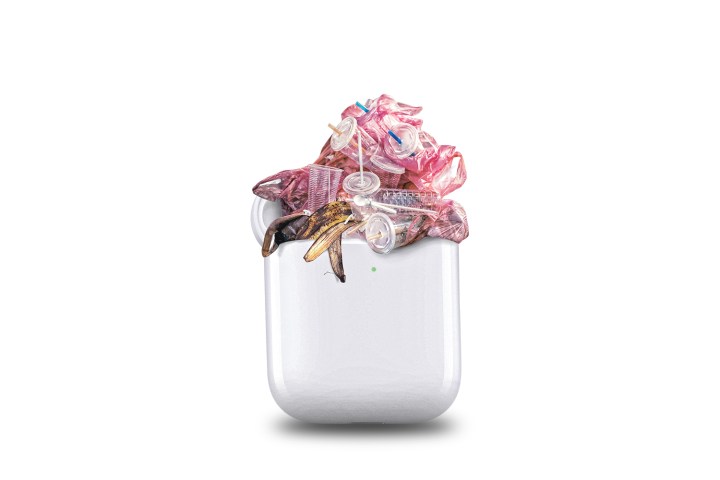
If you were among the first adopters of Apple’s popular AirPods when they came out in 2016, it’s highly likely you’re already considering a new pair.
With some users reporting battery life approaching just 50 percent of the advertised 5 hours after just two years of ownership, AirPods have among the highest turnover of any modern electronics device you can buy. The tiny batteries in each headphone — equivalent to about 1 percent of the battery in an iPhone 7 – appear to begin showing their age for some users after just a couple of years of frequent use.
For many tech fans, this may not seem like much of an issue: The average person replaces their phone every 2.88 years, why should wireless earbuds be any different?
The answer to that question is scarier than you might think. Not only are AirPods and many of their wireless contemporaries nearly impossible to repair, there’s also often no proper way to dispose of them safely.
In fact, in many ways, those tiny wireless earbuds you love are the perfect symbol of the tech industry’s perceived lack of environmental responsibility, love of profits, and flippant attitude when it comes to the e-waste it creates.
Impossible to fix
AirPods and many headphones like them are meant to be disposable in fairly short order, but they don’t have to be.
The limitations of small lithium-ion batteries have been well known by manufacturers, engineers, and designers, even as they’ve become the standard for powering portable devices over the past several decades. It’s basic engineering math: Put a small battery in a device, let it recharge a few thousand times, and it will need replacement.

But Apple and other manufacturers often make it nearly impossible to replace old, worn-out batteries, which would instantly alleviate the primary issue plaguing so many “true wireless headphones” that have been in use for an extended period.
“The list of tools that you need to get into an AirPod implies that these are not meant to be repaired, or refurbished, or resold to anybody else,” says Kevin Purdy from iFixit, a website that provides teardown and repair guides for popular tech gadgets, and has done a full teardown of both generations of AirPods. “It is all but impossible to do anything to them without damaging them and making them useless.”
That’s because, instead of using screws, clips, or other removable and replaceable attaching mechanisms, Apple’s AirPods and plenty of other headphones like them are glued together from the factory. This gives them a sleek, creaseless look but it also makes them nearly impossible to crack open to replace the batteries inside, even if all other functions of the

In fact, replacing the battery in a pair of AirPods is so difficult that it could actually be dangerous; puncturing a lithium-ion battery pack by accident while attempting to open the headphones for repair could cause a fire.
While the AirPods are the best-selling true
“As things get smaller, and manufacturers get greedier, things become so much more difficult to give a new life once the previous owner has discarded them,” says Amber Schmidt, the Manager of Technology Refurbishment at non-profit organization Free Geek.

iFixit uses a 0-10 scale for rating the repairability of products. The highest-scoring true
The reasoning behind this design seems simple enough: Repairs are bad for profits.
One expert we interviewed was quick to share her own opinion on the subject: “It’s all upside for them,” says Gay Gordon-Byrne, executive director of the Repair Organization, “They get to sell another set.”
Nowhere to go
So, if you can’t fix your AirPods or other true
When it comes to AirPods, you really only have one good option.

The only way Apple recommends getting rid of aging AirPods is via its in-house trade-in service, which provides buyers a shipping label to mail the devices back to the company for them to be properly disposed of. Buyers get no credit for returning the headphones for proper disposal.
AirPods are so well-glued together, it’s unclear whether even Apple is willing and able to remove and replace batteries without rendering the headphones totally unusable.
We reached out to Apple for clarification as to whether batteries can be replaced, or if those $69 battery replacement AirPods are simply brand new AirPods — as well as to ask several other questions regarding Apple’s design and recycling processes. The company would only speak to us off the record, but did point us to several public sources that discussed lithium-ion batteries, links to its recycling programs, and a Medium article about the lifecycle of AirPods. Our contact did not comment on whether the batteries are replaceable.

Again, Apple is not the only, or even the biggest culprit here, it’s just got the most popular earbuds by a pretty wide margin. Other headphone manufacturers don’t even offer in-house recycling. What’s worse, the thousands of e-waste facilities in North America aren’t prepared to deal with disposing of true wireless earbuds.
“Often what happens on the electronics recycling side with items that can’t be easily disassembled is that they’ll get shredded,” says Amanda LaGrange, CEO of Tech Dump, a Minnesota-based e-waste recycler. “You can’t shred these things because they have lithium-ion batteries in them, and that causes a very significant fire hazard.”
As a result, true
To make matters worse, most waste companies have no blueprint as to how to properly decommission these headphones so they do not pose a fire risk. Apple in particular hasn’t don’t its best to communicate with the thousands of e-waste recyclers in the United States outside of the select few with which it holds contracts, leaving companies like Tech Dump in the dark as to how to properly dispose of its

In fact, LaGrange says the company doesn’t even know which e-waste facilities have Apple contracts.
“There is no specific place that I can go to and say, ‘Ok, these AirPods came in and because we don’t have the training that we would ideally have, or the tools and the manuals that we would ideally have, instead we should [send them] here.’”
As of May, Apple had publicly acknowledged a contract with Winstron GreenTech, but declined to name any other recyclers with which it contracts.
Instead, e-waste recyclers are left to their own devices, often relying on iFixit teardowns and other third-parties to show them what is inside the products they’re sent for disposal.
“For only a few to have the scoop on how to make sure this is done properly, it’s not responsible design at all,” says LaGrange.
The bigger e-waste problem is simple dollars and cents. Even when wireless earbuds are easy to take apart by hand, doing so might not actually be worth what it costs to pay employees to disassemble them. In the same article in which Apple confirmed that Winstron GreenTech was an e-waste partner, Winstron confirmed that portions of AirPods can be recycled, including the battery, but that the value of what is recovered doesn’t cover the cost of recovering it. In the case of AirPods, at least, Apple – to its credit –pays Winstrom the difference.
A growing problem
It’s worth noting that, though true wireless models have been on the market for a few years now, they have yet to inundate facilities like Tech Dump.
As they continue to grow in popularity — 12.5 million pairs of
Right to repair
Recycling, especially of iPhones, has been a key source of publicity for Apple in recent years, with the company spending significant money to ensure that it has the capacity to properly dispose of its phones.
According to experts like Purdy, though, that’s not enough.
“They can tout their new recycling facility and laboratory that they’ve created which is a good thing to have, much like sandbags are good in the case of a flood,” he says. “The best thing to do is to keep a product out of the waste stream.”
As consumers of these products, it’s our responsibility to demand more from those who make them, and to do our best to ensure that what we are purchasing won’t end up in a facility like LaGrange’s until many years down the line.
The most obvious solution to the true wireless headphone problem (and the overarching problem with e-waste in general) is to make products with relatively standard parts that can be easily fixed by professionals without training.
“People used to fix their stuff all the time,” says Gordon-Byrne. “There used to be little fix-it shops all across America. It’s just that they couldn’t get the parts, they couldn’t get the tools, they couldn’t get the diagnostics, and they went out of business.”
Cutting the waste
In demanding that manufacturers like Apple and others design true
And true
The long-term solution to this problem may be legislative, with advocates like Gordon-Byrne pushing officials to write laws that would prevent manufacturers from selling electronics in the United States without clear end-of-life plans and repairability. Until then, unfortunately, it’s on all of us to try to make smarter purchasing decisions.
Change can start as small as a new pair of earbuds.
If there isn’t a teardown or iFixit rating for the pair of true
When doing research for any new product, check out websites like iFixit for repairability scores, and consider donating or passing down used — but still functional — electronics to organizations like Free Geek, which repurpose them for those in need.
As for that aging pair of AirPods? Dispose of them properly through Apple. And for your next purchase, consider buying something that isn’t as overtly disposable. For now, that’s the best any of us can do.
Editors' Recommendations
- This accessory turned my AirPods into a giant mech head
- Watch all of Apple’s Far Out event videos: iPhone 14, Apple Watch 8, and AirPods Pro 2
- Are Apple’s AirPods Max headphones really worth $549? Never say never
- Last chance to save on Apple AirPods, Samsung Galaxy Buds for Prime Day
- Why now is the best time to buy the latest AirPods and iPad




